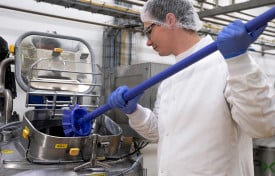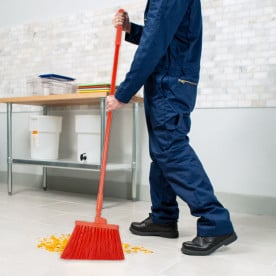Safety & Personnel

- October 12, 2024
We’ve shared some of the hidden costs that can come with insufficient or ill-fitting personal protective equipment (PPE). There are additional challenges that come with gear that must not only protect from danger but also protect from cold weather.
Below we share some of the gear and tips that will help keep your workers safe, warm and dry during the winter season or in cold storage areas.
Tingley Jackets: Tailored to Your Needs
A functional and warm work jacket is indispensable during cold weather months. But like any jacket, they’re not one-size-fits-all. Tingley SYNC System®
- September 08, 2024
There’s no universal solution for a successful Lockout/Tagout program, but it is important to understand the difference in padlocks. The key to understanding lies in the names: “keyed alike” and “keyed different.”
In this guide, we help any organization with Lockout/Tagout needs choose between keyed alike or keyed different padlocks to implement the best system in place for unique needs.
Related: Build a Safety, Protection
- August 24, 2024
Nelson-Jameson is a champion of workplace safety, offering up tips and the right tools to protect workers. In this article, Nelson-Jameson Product Manager Courtney Boeger shares how you can protect staff while preventing costly fines from OSHA. Read on to learn about our approach. Note: This article was originally authored for Industrial Safety and Hygiene News.
- July 10, 2024
Avian Flu H5N1 has brought a spotlight back to the world of personal protective equipment. In fact, the CDC released new recommendations in May with specific PPE protocols.
However, proper PPE is an evergreen tool for own protection as well as food safety regardless of new potential contaminants.
Recently, Nelson-Jameson joined the Wisconsin Cheese Makers Association for a discussion where a panel of dairy industry experts discussed H5N1’s effect on PPE, innovations, and hidden costs when not using the best choices in PPE. Read on to learn more.
From Toes to Above the NoseProtecting every area of the body with PPE is incredibly important when working with food ingredients. From boots to gloves to eyewear, protection helps prevent cross-contamination and injury. However, comfort and ease of use can be equally important.
And head and eye protection is exceptionally important with H5N1, as humans who have been impacted by H5N1 tend to have symptoms appearing in their eyes. The CDC has made the recommendation that safety goggles or face shields be worn.
Pete Butorac, Technical Sales Manager specializing in Safety/PPE for Nelson-Jameson, joined the panel to discuss the importance of eye protection among other protective headgear and offered some tips on what to look for during the evaluation of eye and head PPE.
Here are some tips on what to look for in eyewear:
- Anti-fog bond
- Scratch resistance
- Interchangeable prescription lenses
- UV protection
- Full circumstance coverage
- Lightweight materials
Features to look for in head PPE:
- Air vents that can be toggled on and off
- Rear head coverage
- Add-on ear muffs
- Cooling inserts
- Reflective stickers for visibility
- Color-coding system to prevent cross-contamination
During the panel, Butorac emphasized the importance of comfrot in addition to protection.
“The easier it is and the more comfortable it is, the more likely it is to be used—and that's ultimately what we need everybody to do is use the stuff that's going to protect them.”
Hands-on Protection and Hidden Costs
Gloves are among the most consumable pieces of PPE in the dairy industry, but the cost goes far beyond the glove itself. As one panelist pointed out, gloves can cause obvious dermal issues and often-overlooked muscle issues. Glove tears can lead to increased glove thickness, which is more taxing on the hand and can lead to costly injuries.
Additionally, the hand is the most common site affected by occupational skin disease, impacting almost 2 million people with costs of up to $2 billion annually.
What to look for in protective gloves:- Adequate gripping ability and cut resistance
- Chemical protection
- Flexible and lightweight
- Touch screen compatible
- Suitable for extremely high and low temperatures
High-quality gloves benefit both employees and employers. Employees can minimize exposure to harmful chemicals and toxins while reducing pain and discomfort, which improves job satisfaction. Quality hand protection also improves organizational efficiency by reducing waste and employee time off for recovery.
With thousands of options with different materials, textures, lengths, colors, and shelf life, gloves are not one-size-fits-all. So be sure to find a supplier that is and can meet all of your unique needs.
Your One-Stop Shop for PPEAvian Flu H5N1 has resurfaced the conversation around PPE. It’s as important as ever to ensure that your team has equipment that is equal parts safety and comfort.
Nelson-Jameson is your single-source distributor for PPE, combining the expertise and technical support to protect your entire team while consolidating your supply management!
- April 14, 2024
Highly Pathogenic Avian Influenza (HPAI) is a virus that can infect both domestic poultry and wild birds. However, research has shown that mammals such as dairy cattle can contract the Avian flu virus if they come into contact with infected birds or contaminated materials. Older cattle are more susceptible to infection and may exhibit symptoms such as fever, reduced appetite, and reduced milk production quality and quantity. Fortunately, infected cattle usually recover within 2-3 weeks.
According to USDA, FDA, and CDC reports, the Avian Flu has been found in unpasteurized milk from affected herds. However, the reports indicate that the US dairy supply is safe and free from contamination. Dairy producers must exclude milk from human consumption if it is sourced from an unhealthy animal.
A robust cleaning and sanitation program can help prevent the spread of HPAIv. To ensure the safety of employees and products, Nelson-Jameson offers a range of protective equipment - July 06, 2023
Every year, destructive and deadly dust-related fires and explosions affect a wide range of industries around the globe, including the food processing industry.
According to the 2021 Combustible Dust Incident Report Summary by Dust Safety Science, in the United States alone, there has been an average of 133 fires, 30 explosions, 39 injuries, and one to six fatalities per year (between 2016 and 2021).
To help manage dust-related fires, flash fires, and explosion hazards, the NFPA® introduced NFPA 652: Standard on the Fundamentals of Combustible Dust .
All facilities that handle or produce combustible dust, or particulate solids that may become dust, are at risk of a potential dust explosion. NFPA 652 defines combustible dust
- May 23, 2023
This webinar provides crucial information on preventing and mitigating combustible dust hazards, emphasizing the potential dangers posed by fine particles in specific environments, including the risk of fires, explosions, and safety hazards for personnel. Enhance your awareness and knowledge of combustible dust dangers by watching the Dust Busters Webinar, led by industry-leading experts in dust hazard prevention. The webinar covers essential topics such as understanding combustible dust explosions, conducting site dust hazard assessments, implementing mitigation strategies, and addressing frequently asked questions. Tailored for individuals in plant operations, the webinar is particularly relevant for those in processing facilities, manufacturing plants, and similar environments prone to generating combustible dust.
- September 29, 2022
In April of this year, OSHA - Region V - WI published a Local Emphasis Program (LEP) established for the purpose of scheduling and conducting inspections within the Food Manufacturing Industry (click here for full details.)
The launch of the LEP allows for greater “outreach, education, training, and enforcement activities.” For many reading this, this specific LEP may not pertain to your facility. However, the rationale behind this special program is something that we can appreciate across the food industry. Reminders like this in our busy, hectic schedules can do a lot “to encourage employers to take steps to identify, reduce, and eliminate hazards associated with exposure to machine hazards during production activities, and off-shift sanitation, service, and maintenance tasks.”
Let’s face it, a food processing
- September 27, 2022
Safety is a major concern in any workplace, especially when working with machinery and equipment. This Lockout Tagout Buying Guide is your comprehensive resource to understand and implement lockout tagout procedures effectively, ensuring the safety of employees and preventing serious accidents. Lockout Tagout (LOTO) is a critical protocol that prevents the unexpected start-up of machinery during service or maintenance, safeguarding workers from potential hazards. This guide covers various aspects, including the definition and use of lockout and tagout, the importance of hazardous energy control, OSHA requirements, and steps for complete OSHA compliance. Delve into the details of lockout tagout procedure steps, the responsible parties for LOTO, training requirements, and scenarios where lockout must be applied. Learn about different lockout tagout devices, their definitions, and uses, ranging from cable lockouts to valve lockouts, ensuring a thorough understanding of the tools available
- February 20, 2022
5S is more than a program, it is a comprehensive system for organizing spaces so work can be performed efficiently, effectively, and safely. This system focuses on putting everything where it belongs and keeping the workplace clean, which naturally promotes a safer workplace with more efficiency.
When implementing a 5S system, it is important to remember to start small. Start with a pilot project to get a feel for if/what employee training is needed—how to implement the system, how to track progress, and how to celebrate success.
5S IS A FIVE-STEP PROCESS:
- Sort: Separate the tools that are needed to get the job done.
Remove everything else. - Set in Order: Place all relevant tools within reach of operatives and reduce the need to be away from
- Sort: Separate the tools that are needed to get the job done.







